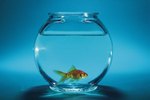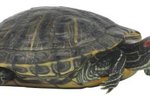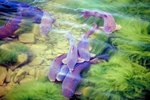
The bristlenose pleco, aka the bushy-nose pleco, is a small, colorful algae-eating catfish. Several plecos from the genus Ancistrus go by this name. Most are three to five inches long depending on the species tanks. They get along well in a planted tank. While they will help keep algae in check, they do need additional feedings.
Algae
Most people get plecos to help control algae. And bristlenose plecos will enthusiastically rasp algae off surfaces in the tank. However, they are not magic cleaning machines. They will only eat algae, not fish waste or other debris in the tank. They will quickly eat algae in most tanks, and will either need to be moved to another tank or fed supplemental food once they finish off the algae.
Driftwood
In addition to algae, most plecos will also use their rasping mouths to eat small amounts of driftwood. Make sure that any tank with a bristlenosed pleco has some natural driftwood in it. Only use driftwood from a pet shop; driftwood from elsewhere can contain chemicals and salts. Bristlenose plecos get extra nutrients, like lignin and cellulose from scraping driftwood.
Prepared Foods
Many pet shops sell prepared foods for plecos. They come in a variety of forms, including wafers, flakes and pellets. Wafers and pellets often come in sinking varieties, which are important for bottom feeders like bristlenose plecos. Many brands and variations are available. Look for brands that rich in vegetable matter. Prepared foods can make great staple foods for a bristlenose pleco.
Veggies
Bristlenose plecos can also benefit from supplemental feedings of vegetables. Grocery store veggies like spinach, kale, romaine lettuce, peas, carrots and green beans are suitable pleco foods. Some of them, like zucchini and carrots, work better when blanched first. Most veggies float, so they need to be weighed down with aquarium weights available at pet shops, or held in place with a veggie clip. Both of these items are available at most pet shops.
References
Photo Credits
-
Hemera Technologies/AbleStock.com/Getty Images




